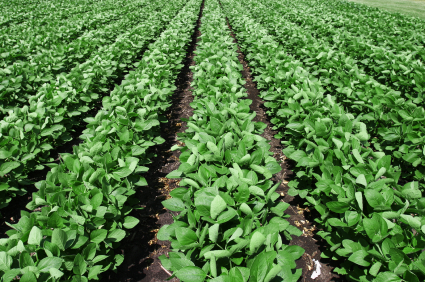 A soybean field in summer. Farmers are getting fed up with Monsanto’s soy seed monopoly.
A soybean field in summer. Farmers are getting fed up with Monsanto’s soy seed monopoly.
UPDATE: This report refers not to the current year but to the 2009 crop year, which according to the USDA did see a slight drop in US GMO soybean plantings, as predicted. New estimates on the 2010 crop year should be forthcoming so we can ssee if this really was a blip or a trend.
_______________
Is it possible that last year we reached Peak Monsanto? (via the Non-GMO Report):
Low commodity soybean prices, attractive premiums, and rising prices for genetically modified soybean seed are leading American farmers to plant more acres of non-GMO soybeans this year.
Representatives with soybean associations, universities, and grain buyers all say that demand for non-GMO soybeans is growing, leading to more non-GMO acres.
Genetically modified Roundup Ready soybeans have taken an increasingly larger percentage of U.S. soybean acreage each year since their introduction in 1996, reaching 92 percent in 2008.
But this could be the first year that the trend reverses. Grover Shannon, a soybean breeder with the University of Missouri, Delta Research Center, thinks non-GMO acreage could account for 10 percent of total soybean acreage this year.
This analysis comes from The Organic and Non-GMO Report so it’s fair to be skeptical. But it does quote a rep from a state soybean associations, not generally bastions of sustainable ag proponents:
“We are seeing more interest in growing non-GMO soybeans,” says Mark Albertson, director of marketing, Illinois Soybean Association.
… Albertson has talked to several farmers who haven’t grown non-GMO soybeans in eight years, but will this year because of the premiums.
Grain companies large and small are contracting farmers to grow non-GMO. “We called all the companies buying non-GMO, and about one-half of them had enough acres,” Albertson said.
The reasons run the gamut from farmer anger at Monsanto’s price increases for its GM seed and its RoundUp pesticide to the recognition that the rise of resistant weeds have reduced the rationale for going GM in the first place to another kind of increasing resistance — among consumers towards GM foods.
Of course, it’s entirely possible that this is a blip and not a trend — we won’t even know for certain that total planted acres of GM soybeans have declined until later this year. Still, when you combine this news with the Justice Department’s active antitrust investigation into Monsanto, you may legitimately conclude that the tide may be close to turning against the biotechnology giant.



